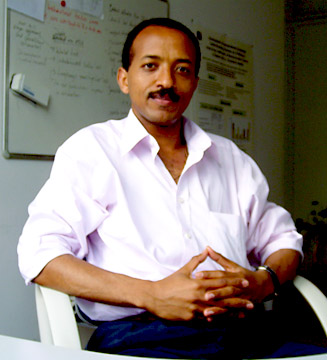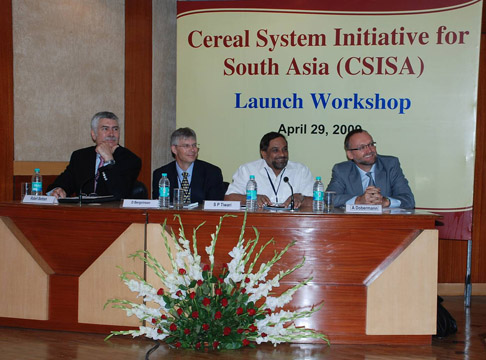Board of Trustees of CIMMYT
27 August 2008
1. CIMMYT strongly believes that the CGIAR needs to undergo substantial reform if it is to make a significant contribution in the future to pro-poor agricultural development in the world. Business as usual is not an option, and minor changes will result in a damaging wave of frustrated expectations which will further erode the capacity to perform of the CGIAR and of each of the Centers, CIMMYT included.
The current complexity of the CG system results in inefficiency and ineffectiveness. This can be seen, for instance, in the number of system-wide control institutions and structural units which have emerged over time without their true added value being challenged.
2. We strongly support reform options and decisions that:
a. Streamline and focus our mission. Enhancing through scientific research the contribution of agriculture to sustainable poverty reduction in developing countries is the core of our mission. The three strategic objectives proposed by WG1 fit very well with CIMMYT’s mission and we endorse them. The areas of activities defined so far in the documents emerging from the change process also align well with the on-going activities of CIMMYT and the proposed framework allows for initiation of new activities which may require greater focus.
b. Align CGIAR and Centers’ research programs, missions, and objectives, as well as stakeholder and donor priorities, through a clear, simple, and highly effective system of incentives. The CGIAR Fund and the mechanism of programmatic contracts that has been proposed by WG3 can serve this purpose, and CIMMYT endorses their creation. Establishing a significant Fund would be a potent signal of political commitment by the donors, and would in all probability catalyze further functional and structural reforms. Such a Fund may also provide a much needed vehicle for structurally addressing core funding needs of the Centers’, such as long-term, stable support for the gene banks or for the advanced research needed to sustain a continuing flow of technological and institutional solutions and alternatives.
c. Drastically improve the governance of the CGIAR system, including the establishment of a system-level Board vested with legitimate power and authority to govern the system on behalf of all stakeholders. This board must be able to directly interact and consult with stakeholders and strategic partners; set strategic objectives and priorities, including the allocation of funds, promote mission focus; stimulate alignment of initiatives and synergistic use of the current and future assets of the system; and create healthy levels of competition among alternative research providers. The CIMMYT Board of Trustees endorses the system-level Board proposed by WG3 and the recommendations of the governance section of the draft report of the Independent Review Panel. This may require a new distribution of responsibilities between the System’s and the Centers’ Boards; we welcome the open and positive consideration of concrete and detailed plans for this kind of governance change. The constitutional rules of the new System Board should be such that it can effectively engage the diversity of stakeholders and avoid imbalances of power among members.
d. Revitalize the position of the CGIAR in the global development community and, in particular, in the rapidly changing global science system. This implies a new way of thinking about, and of working in partnerships. CIMMYT has a tradition of working in partnership with many different stakeholders inside and outside the CGIAR system, including such different models as the Challenge Programs, the Alliance with IRRI, the joint program with ICARDA, and new multi-stakeholder initiatives and private-public partnerships supported by the Gates Foundation in Africa. We are particularly concerned with the need to reinvigorate our alliance with the national agricultural research and innovation systems in the developing world, and with tailoring in a better way the work of the CGIAR to the particular needs and conditions of the developing regions of the world. The recommendations of WG2 would allow us to expand and build upon that tradition, and CIMMYT is committed to playing an important role to move forward in this critical component of the CGIAR reform process.
e. Enable the CGIAR’s work to be organized around clear and enforceable agreements that allow the Centers, the scientists and their partners to carry out their work in an environment conducive to top quality, mission-focused and impact-driven research for development. The system of programmatic contracts between the CGIAR Fund/Board and the Centers proposed by WG3 fits this need and we endorse it. Such a system allows the Centers to carry out other activities not covered by the contracts, and clearly defines those lines of work and results for which we are to be held accountable to the CGIAR. This system can also be a very powerful instrument to promote and support work and product-driven alignment and convergence of Centers.
f. Significantly reorganize structures and bureaucracies that are currently ineffective, streamlining all system-level support and administration functions in a single, efficient and small unit under the responsibility of the system Board and its Chair and CEO.
3. In the coming weeks we will hear valid arguments that many details remain unclear, that the changes do not go as far as needed, that the commitment to the change process of some key stakeholders remains unclear, that more time is needed for further reflection and consultation, and so on. CIMMYT welcomes all opportunities for building a solid consensus around a change platform and, in particular, for seeking greater clarity about the specifics of the change process. But CIMMYT clearly and forcefully states that we strongly favor making the key decisions now. There is more than enough analysis to support a decision to move forward with a clear set of concrete, substantial reform goals, and CIMMYT is prepared to move the process forward.
4. This process of change must very soon enter into a new stage of implementation. We urgently need to restore the focus on the challenges that we have in front of us. The CGIAR should not dedicate more resources than are essentially needed to strategize about boards of directors and funding mechanisms, when there is a food crisis on hand.
 Girma Tesfahun, post doctoral fellow based at CIMMYT’s office in Addis Ababa, was elected president of the Agricultural Economics Society of Ethiopia (AESE) for the next two years. The AESE’s general assembly elected Tesfahun at their 12th annual conference from 14-15 August 2009 in Addis Ababa. The executive committee has five members and includes senior economists from universities, national agricultural research programs, the private sector, and staff from the Consultative Group on International Agricultural Research (CGIAR) who are based in Addis Ababa.
Girma Tesfahun, post doctoral fellow based at CIMMYT’s office in Addis Ababa, was elected president of the Agricultural Economics Society of Ethiopia (AESE) for the next two years. The AESE’s general assembly elected Tesfahun at their 12th annual conference from 14-15 August 2009 in Addis Ababa. The executive committee has five members and includes senior economists from universities, national agricultural research programs, the private sector, and staff from the Consultative Group on International Agricultural Research (CGIAR) who are based in Addis Ababa. The Cereal Systems Initiative for South Asia (CSISA) was formally initiated 29 April 2009 in Delhi, India. This large project, which is jointly funded by the Bill & Melinda Gates Foundation and USAID, brings together public- and private-sector organizations and international agricultural research centers (IRRI, CIMMYT, IFPRI, and ILRI) to reduce hunger and increase food and income security for resource-poor farm families in South Asia. The launch of this project comes at a critical time for South Asia, home to 40% of the world’s poor with nearly half a billion people subsisting on less than USD 1 a day. The project’s targeted countries of Bangladesh, India, Nepal, and Pakistan are struggling to boost grain supplies in the wake of growing demand and strained natural resources. CSISA aims to increase the cereal crop yields of at least 6 million farmers in these regions by at least 0.5 t/ha. With this huge task ahead, time is precious and so many parallel planning activities and interviews for local staff positions were conducted alongside the launch to speed the project’s progress.
The Cereal Systems Initiative for South Asia (CSISA) was formally initiated 29 April 2009 in Delhi, India. This large project, which is jointly funded by the Bill & Melinda Gates Foundation and USAID, brings together public- and private-sector organizations and international agricultural research centers (IRRI, CIMMYT, IFPRI, and ILRI) to reduce hunger and increase food and income security for resource-poor farm families in South Asia. The launch of this project comes at a critical time for South Asia, home to 40% of the world’s poor with nearly half a billion people subsisting on less than USD 1 a day. The project’s targeted countries of Bangladesh, India, Nepal, and Pakistan are struggling to boost grain supplies in the wake of growing demand and strained natural resources. CSISA aims to increase the cereal crop yields of at least 6 million farmers in these regions by at least 0.5 t/ha. With this huge task ahead, time is precious and so many parallel planning activities and interviews for local staff positions were conducted alongside the launch to speed the project’s progress.